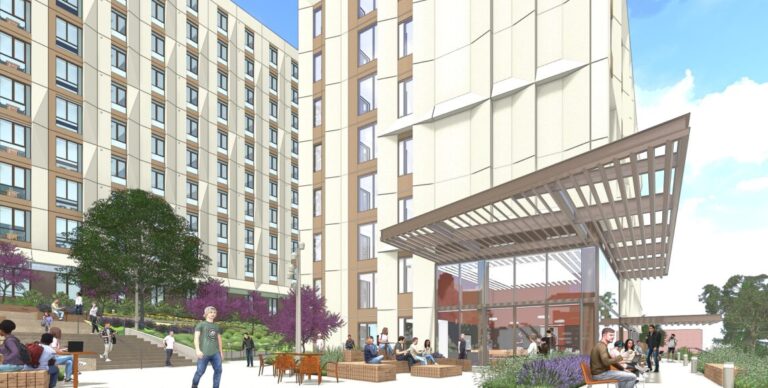Five Steps to Success: Managing Your Healthcare Project

Construction in an occupied medical facility can be significantly disruptive to ongoing operations, impacting the patient and visitor experience as well as staff performance. Potential risks may include the spread of contaminants causing hospital acquired infections (HAI), poor exit surveys negatively impacting reimbursement and logistics mis-steps resulting in inefficient staff coordination.
Five critical steps taken prior to mobilizing construction activities can make the difference between a successful project and one fraught with challenges. Together, these steps serve to minimize disruptions in an occupied facility, whether the project includes high-risk areas like operating rooms, isolation or emergency rooms, or less risk-prone environments such as medical office buildings.
1. Pre-construction Site Inspection: Ideally, the design team will have surveyed the site during design development and reviewed any available as-built drawings. At minimum, the contractor should conduct a preliminary site inspection prior to construction. A site inspection serves to identify existing mechanical, electrical, plumbing, etc. and reveal potential challenges for the proposed project. This discovery will allow early generation of any necessary Requests For Information and will assist in maintaining schedule.
2. Establish Closeout Documentation Requirements: Even before the project begins, it is important to establish the closeout documentation requirements such as commissioning, as-built drawings, training, OM manuals, test reports, warranties, etc. This allows the contractor to notify sub-contractors, material and equipment suppliers of necessary documentation well in advance and allows for timely scheduling of testing and commissioning services.
At the end of the project, the contractor will provide the agency having jurisdiction (AHJ) with the proper documentation for final inspections including test reports, flame spread information and more. In preparation, the contractor and the project team (architect, engineers, owners, sub-contractors) should discuss key personnel, equipment and documentation that will be required at the final inspection. These typically include:
- Updated plans identifying smoke, fire, walls/barriers, dampers
- Certificate of Occupancy (or Temporary Certificate of Occupancy) issued by the local authority having jurisdiction
- Flame spread and smoke development test information for flooring, wall coverings, curtains, etc.
- Fire and smoke dampers with product information and installation instructions
- Electrical ground resistance test reports
- Third party medical gas certification and test reports
- Fire stopping product information
- HVAC test and balance reports
The AHJ will also require that the contractor furnish ladders, tools, flashlights, two-way radios and a conference area for post inspection review and discussion.
3. Interim Life Safety Plan: Prior to construction, the contractor should request a copy of the facility’s interim life safety requirements, review the drawings and develop a project specific interim life safety plan for facility approval. The approved plan should be posted in a conspicuous place on the job site and provide the following information:
- Project area identification of entrances, pathways etc.
- Daily ISLM/ICRA inspection log
- Emergency egress routes
- Emergency contact list
- Fire control management procedures
- Existing and Temporary partition locations/ratings
4. Infection Control Risk Assessment (ICRA): The contractor and facility/owner should schedule an infection control meeting and conduct a thorough review of the risk assessment procedures well in advance of construction. This meeting routinely covers the following:
- Scope of work
- Noise/vibration monitoring, proximity of construction to patient areas
- Air and pressure monitoring requirements
- Duration of the project
- Containment and transport of construction waste, tools and equipment
- Identification of any MEP shutdowns that will be required
- Standard cleanup procedures
- Project phasing
- Dust control measures, “sticky” mats, etc.
- Locations and types of proposed barriers and barricades, ante rooms, etc.
- Isolation and protection of existing HVAC systems
- Maintenance and recording (log) of negative pressure
- Proposed air filtration plan and procedure
- Dress and personal protection equipment requirements of construction personnel
- Barrier/barricade deconstruction
- Final cleaning procedures
- Documentation requirements
5. Utility Shutdown Plan: Most projects require a temporary interruption in utility services (“shutdown”). When required, the contractor will schedule the shutdown in accordance with the facility’s procedures. Identification and advanced notification of the shutdown must be communicated to the facility staff so that impacted services can be identified and interim measures put into place. This plan will need to be communicated to the hospital’s facilities, clinical and biomed departments so that it is clearly understood what services and equipment will be “down” including the time frame of the disruption. In addition, since shutdowns often occur after hours, an emergency contacts list should be distributed.
Proper research, planning and communication is vital to the successful implementation of a project at an occupied medical facility. These best practices will help to mitigate risks, protect the patient experience and support efficient staff coordination throughout construction. In addition, selecting vendors with certifications in healthcare construction (HCC), Infection Risk Control Assessment (ICRA) and Interim Life Safety Measures (ILSM) should also be prioritized.
The Art of Winning Work in Behavioral Health Facility Development
Winning funding or work in behavioral health facility development is part science, part art.




